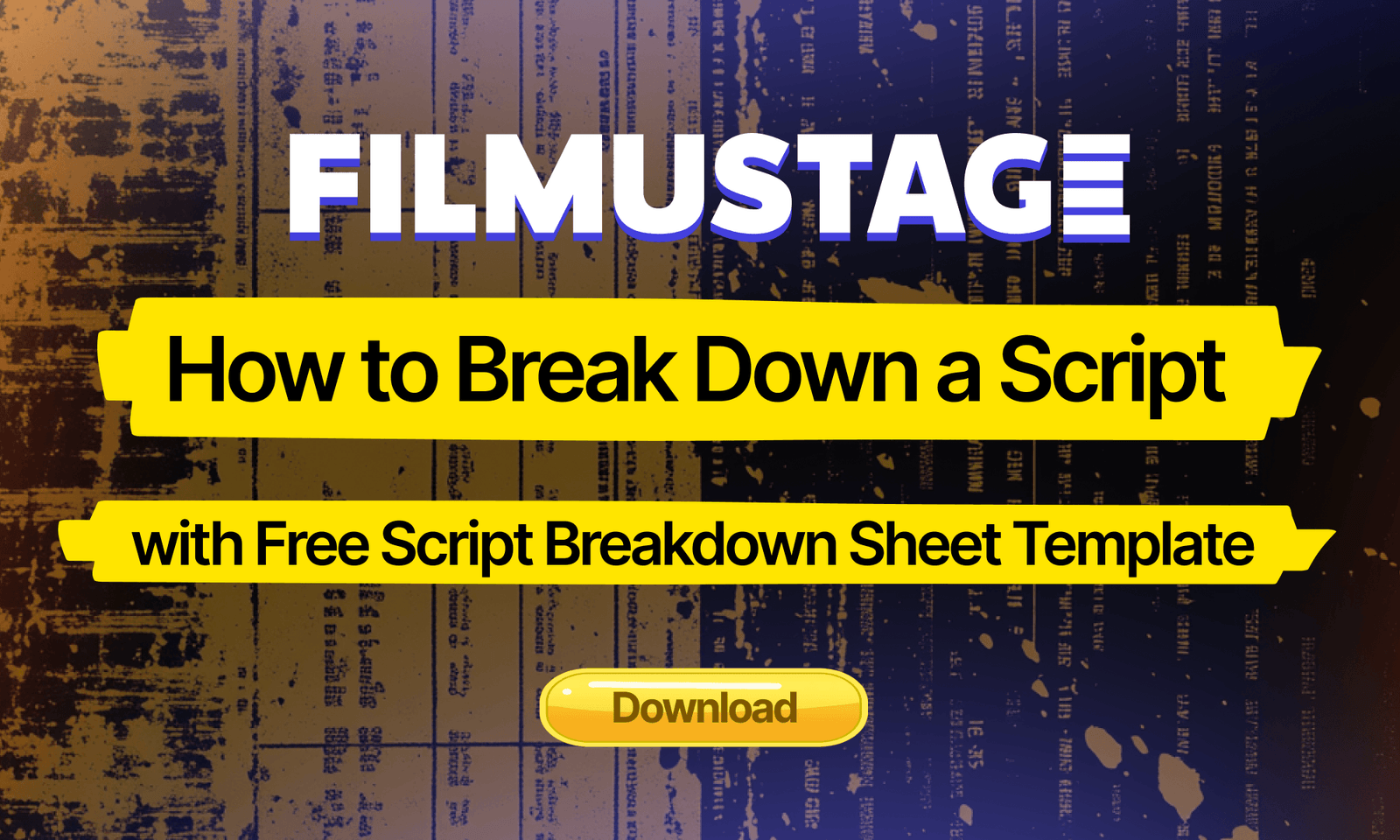How to Break Down a Script (with Free Script Breakdown Sheet Template)
A script breakdown is the foundation of efficient filmmaking. Learn how to track key elements, organize scenes, and enhance your pre-production workflow. Download the free breakdown sheet template or use Filmustage’s AI to automate the process and optimize your production.


Your script is written, the project is moving forward, and now it’s time to to shape your vision into a practical, shoot-ready plan. A script breakdown is the essential process that brings your production into focus — identifying every element needed for each scene, from props and locations to costumes and effects.
In this guide, we’ll walk you through key steps to breaking down a script like a pro — whether you’re doing it manually or using automation to save time. Plus, we’re giving you a FREE script breakdown sheet template so you can put this process into action right away. Let’s get started!
📥 Get Your Free Script Breakdown Template!
Use our structured script breakdown sheet to log every essential scene detail — characters, props, locations, and more.
What Is a Script Breakdown?
A script breakdown is the first crucial step in pre-production, helping filmmakers, producers, and crew members analyze the screenplay and extract all the necessary elements for planning the shoot. This process ensures that every department knows what they need —from props and costumes to stunts and special effects — before cameras start rolling.
With a proper script breakdown, you can budget, schedule, and organize your production efficiently.
Why Script Breakdown Is Essential
Breaking down a script helps in:
- Budgeting: Understanding costs for sets, props, actors, and effects.
- Scheduling: Organizing scenes by location, time of day, and complexity.
- Crew Coordination: Ensuring each department knows what’s needed for a smooth shoot.
- Avoiding Surprises: Identifying potential challenges before they become production issues.
Step-by-Step Guide to Breaking Down a Script

✅ Step 1: Read the Script Thoroughly
Before you mark up anything, read the script multiple times to understand its tone, pacing, and key elements. This ensures that you’re not just breaking it down mechanically but also grasping the creative and logistical needs.
📏 Step 2: Divide Script Pages Into Eighths
A key part of script breakdowns is accurately measuring scene length to estimate how much time and resources each scene will require. To do this, industry professionals divide each script page into eighths. Since one page roughly equals one minute of screen time, this system provides a more precise way to schedule production.
How It Works:
- Draw horizontal lines across each script page, dividing it into eight equal sections.
- Mark where each scene starts and ends. If a scene covers part of a page, it’s logged as fractions of eight (e.g., 1 4/8 pages).
- Record these measurements in your breakdown sheet to estimate shoot durations.
This method standardizes scene length tracking, helping production teams schedule efficiently, allocate resources, and avoid underestimating shot complexity.
🔎 Step 3: Identify Key Elements
Once your script is divided into eighths, the next step is to identify and categorize essential elements within each scene. This ensures that every department—from props to special effects—knows exactly what they need for the shoot.
Key Scene Elements to Track:
- Characters & Cast (🔴 Red) – Speaking roles and their interactions.
- Props (🟣 Purple) – Important objects used in the scene.
- Set Dressing (⚪ Gray) – Decorations, furniture, and ambiance details.
- Costumes & Wardrobe (⭕ Circle) – Outfits for continuity and storytelling.
- Hair & Makeup (✨ Asterisk) – Special effects makeup or unique hairstyles.
- Vehicles & Animals (💗 Pink) – Any transport or live animals involved.
- Special Effects (SFX) (🔵 Blue) – Practical effects such as explosions or fog.
- Visual Effects (VFX) (🔹 Light Blue) – CGI elements needed in post-production.
- Sound Requirements (🟤 Brown) – Important audio elements like music or ambient noise.
- Lighting Requirements (🟡 Gold) – Natural or artificial lighting considerations.
- Camera & Equipment (⬛ Box) – Specialized gear like cranes, drones, or Steadicams.
- Stunts (🟠 Orange) – High-risk sequences needing professionals.
- Extras & Background (🟢 Green) – Additional performers to populate the scene.
For a deeper understanding of why these colors matter and how to use them effectively in a breakdown, explore the Filmustage Guide on Script Breakdown Symbols and Color Codes.
With all scene elements identified, the next step is to organize this information into a structured breakdown sheet.
📋 Step 4: Use a Breakdown Sheet
Once you’ve identified all key elements within the script, it’s time to document them in a structured breakdown sheet. This sheet serves as the master reference for every department, ensuring that cast, crew, equipment, and resources are all accounted for before production begins.
Dentified Key Elements? Document Them Properly!
Get Our Free Script Breakdown Sheet!
A breakdown sheet should include all the critical details of each scene, allowing for easy planning and execution. It serves as a centralized document where all the key elements identified earlier — such as characters, props, locations, and special effects — are recorded alongside other essential production details. This ensures that every department has a clear understanding of what’s required for each scene.
Key Fields in a Breakdown Sheet:
- Production Details (Title, company, and date)
- Scene Information (Location, time of day, estimated duration)
- Set & Weather Considerations (Any specifics that affect shooting conditions)
- Element Breakdown (Categorized and color-coded elements for that scene)
- Approval & Review (For producers and department heads to finalize)
Automate the Script Breakdown Process with Filmustage
The traditional way of breaking down a script — reading it line by line, manually highlighting elements, and filling out a breakdown sheet — is still a reliable method. But let’s be honest: it’s tedious, time-consuming, and prone to human error.
If you’d rather focus on creativity instead of getting lost in paperwork, Filmustage offers a faster, smarter way to get the job done.
Filmustage is an AI-powered script breakdown tool that scans your screenplay and automatically identifies key elements and generates a structured breakdown sheet — no manual tagging required.
Why Choose Filmustage Over Traditional Methods?
🤖 Automated Script Breakdown: Just upload your script, and Filmustage scans your script and automatically identifies key elements like cast, props, locations, and VFX, completing the breakdown in minutes.
🎯 Customizable Tagging: Modify tags, add new categories, and tailor breakdowns to fit your project’s needs.
📜 Script Revision Tracking: Upload new script versions, and Filmustage will detect changes, updating your breakdown while keeping previous settings intact.
📊 Comprehensive Reports: Generate detailed breakdown summaries for storyboards, shot lists, and pre-production documents.
🔗 Seamless Integration & Export: Export your breakdowns directly to industry-standard software like Movie Magic Scheduling and Final Draft, ensuring a smooth transition from breakdown to scheduling and budgeting.
If you love the old-school method, go for it with our free template.
But if you don’t want to waste valuable time on repetitive tasks, Filmustage can handle the breakdown process for you!
From Breakdown to Budget in Clicks
Save time, cut costs, and let Filmustage’s AI handle the heavy lifting — all in a single day.